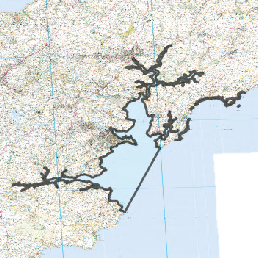

University of Southampton OES Undergraduate Falmouth Field Course 2016 - Group 3 databank and initial findings.
Disclaimer: The views and opinions expressed are solely those of the contributors, they do not reflect the views and opinions of the University of Southampton.


Falmouth Field Course 2016
From 20th June - 2nd July, Undergraduate OES students from the University of Southampton undertook a marine field course within the Fal and Helford SAC site. Students collected data through various methods in order to document the physical, chemical and biological environment within the Fal. Data has been collected from the estuaries, coastal bays and offshore waters of the Fal and subsequently documented by Group 3 within this website.
The Fal
Situated along the southern West Cornish coast, the Fal and Helford ria systems (drowned river systems from the previous glacial maximum) comprise a wide range of marine habitats of vital importance for both ecosystem services and sustainability.
Ecosystem and Environment
Habitats within this site are largely dictated by their relative exposure, with sheltered mudflats in the upper Fal to rocky shores along the Helford coast. These varied habitats accommodate for a vast plethora of nationally important and rare species and communities. From the invertebrate and wading bird communities of the sand and mudflats, which provide crucial functioning to the benthic systems, to circalittoral reefs of Falmouth bay supporting Eunicella verrucosa (a nationally important pink sea fan), it is clear that this area holds great environmental importance.
Chiefly, the extensive maerl (red coralline algae) beds which occur throughout the site support a vastness of flora and fauna, providing key nursery grounds for many species and long term habitat for others such as thornback rays, Raja clavata. These maerl beds are classed as Habitats of Principal Importance under the Natural Environment and Rural Communities Act 2006 because of its importance to ecosystem functioning and vulnerability as an extremely slow growing algae (Birkett et al., 1998).
Fal and Helford ecosystems have been threatened extensively throughout its history due to anthropogenic forcings, which prompted its protection as a Special Area of Conservation (SAC). The estuary system has a long history of metal mining, with its peak in the mid 19th century. As a result from mine tailings and spoil, the Fal estuary has been classified as the most metal polluted estuary in the UK (Bryan & Langston, 1992). Extensive pollution of heavy metals can lead to toxic effects in organisms. Elevated concentrations of copper and zinc has been continually documented in Ostrea edulis (a native oyster) relative to other specimens from around Britain, providing evidence for extensive contamination of the Fal and Helford.
Thus, the continued monitoring of the Fal and Helford SAC site (from the University of Southampton’s yearly Falmouth field course, for example) is imperative to ensure the continued protection and sustainability of the ecosystem and its services.

References
Birkett, C.A., Maggs, C.A., Dring, M.J. 1998. Maerl (Volume V). An overview of dynamic and sensitivity characteristics for conservation management of marine SACs, Scottish Association of Marine Science. (UK Marine SACs Project).
Bryan, G.W. and Langston, W.J. 1992. Bioavailability, accumulation and effects of heavy metals in sediments with special reference to United Kingdom estuaries: a review, Environmental Pollution, 76, pp.89-131.
Species groups with records for ‘Fal and Helford’ (no date) Available at: https://data.nbn.org.uk/Reports/Sites/GA000327UK0013112/Groups (Accessed: 23 June 2016)

Fal and Helford SAC region, South West Cornwall, UK. (www.data.nbn.org.uk)